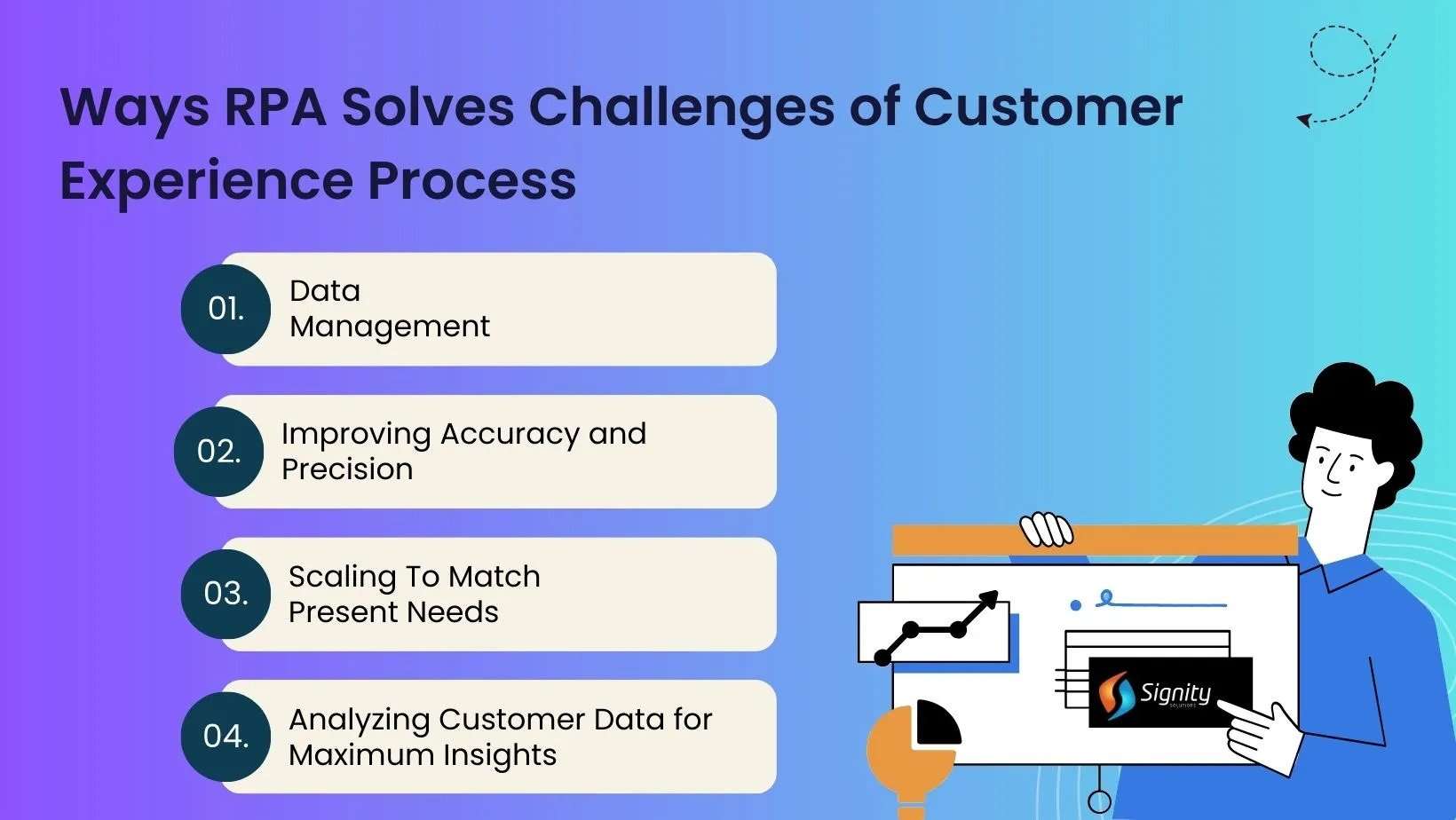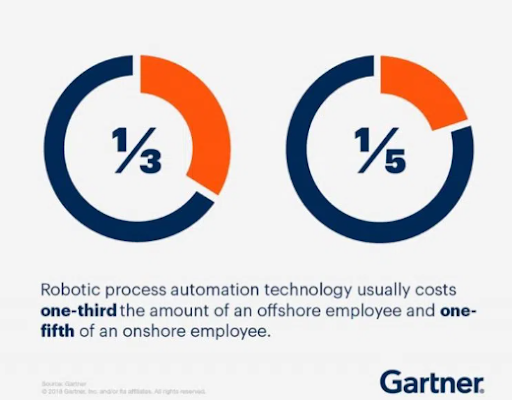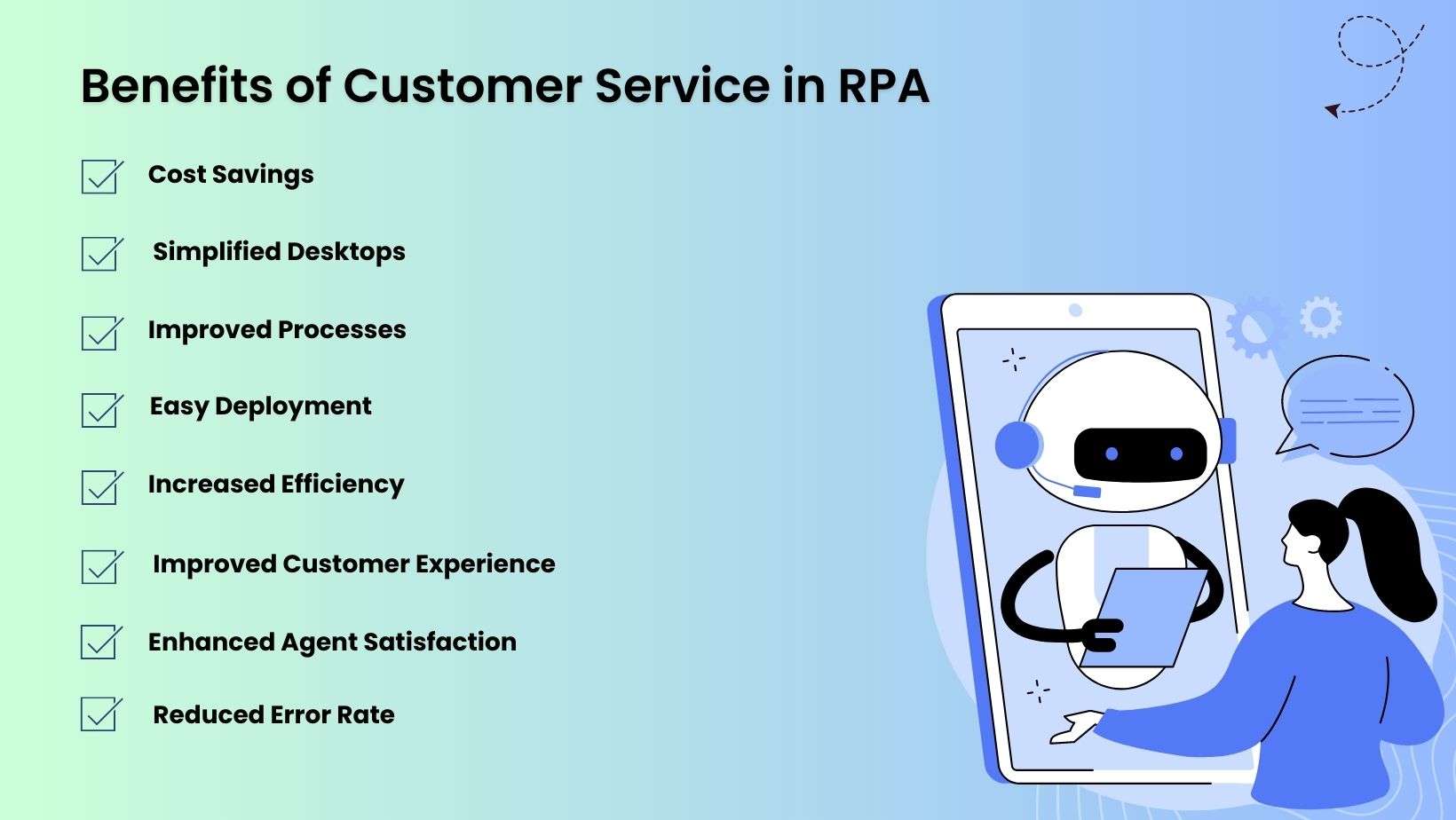How Robotic Process Automation (RPA) Improves Customer Satisfaction?
Learn how RPA is revolutionizing customer satisfaction by automating repetitive tasks, reducing errors, and improving response times. With RPA, businesses can deliver exceptional customer experiences, ultimately raising satisfaction levels to new heights.

“Customer Satisfaction and Digital Transformation” - The Two Terms No Business Can Ignore in Today’s Era.
RPA is excellent, but why does it need to be introduced in customer service? If your thoughts are similar, this blog is for you!
Robotic Process Automation (RPA) can indeed boost customer service by reducing the workload associated with administrative and back-office tasks.
Software robots, which are part of RPA systems, can expedite customer service processes by collecting information and documents from various systems, managing service requests, and keeping customer records up to date.
These days, the most buzzed, debated, and blogged topics revolve around RPA, AI, and the untold ways they impact our lives. Due to this uproar, Robotic Process Automation has also become the buzzword among customer-facing business operations.
After all, the whole idea of running a business goes around the customers. But, especially when customer-centric operations move online, businesses face global competition and struggle to hold onto potential customers' attention.
Here, RPA or Robotics Process Automation kicks in as one of the newest frontiers in customer service.
What is an RPA in Customer Service?
RPA in customer service specifically refers to the application of RPA technology in the customer service field. This involves automating various processes within call centers, deploying chatbots to assist customers, implementing voice assistants, and more.
Using RPA to automate certain customer interactions, allows customer service agents to allocate more time and attention to critical interactions.
Simultaneously, it enables them to handle simpler customer inquiries with immediate responses and solutions.
Despite a series of features to boast, the most significant benefit of RPA is that it helps automates mundane and time-consuming tasks. From automated data extraction with ~100% accuracy to efficient improvisation allowing human staff to do what they do best, RPA offers several solutions.
According to Grand View Research, the Global Robotics Process Automation market is predicted to reach $3.97 billion by 2025, with a CAGR of 31.1% over the forecast period.
RPA makes a dominating presence in today’s industry space. Here, we have pocketed ways in which you’ll learn how RPA can improve customer experience.
| Irrespective of domain, businesses looking to strike a balance between costs and flawless service must implement RPA. Also, streamlining support operations can be a windfall. |
Ways RPA Solves Challenges of Customer Experience Process
Let’s see how it solves key challenges of the customer satisfaction process.

# Challenge 1: Data Management
Often, a company’s employee time that could be invested in interacting and delighting customers is dedicated to completing tedious, repetitive, and monotonous tasks - filling forms, extracting and transferring data, generating reports, etc.
Still, the question is: can RPA be used to automate customer relationship management?
Solution: RPA Focuses on Tasks That Nurture Customer Relationship
Robotics Process Automation helps businesses automate mundane tasks, which increases efficiency and minimize costs. So, when machines manage repetitive, monotonous tasks, employees get ample time to invest in value-driven tasks associated with innovation, creativity, connecting customers, and nurturing customer relationships.
Furthermore, RPA allows employees to focus on tasks that impact customer relationships. RPA helps customer agents by offloading repetitive tasks to focus more on up-leveling their skills and the nature of customer relationships.
Here’s an example to understand it better.
A bank transformed its claim process with bots for managing 1.5 million requests every year. And, surprisingly the overall work done by 85 bots was equivalent to the output of 200 full-time human employees, making it 30% of the total cost.
Therefore, using RPA bank witnessed increased productivity, allowing it to utilize the saved time and cost in value-driven tasks related to building customer relationships.
# Challenge 2: Improving Accuracy and Precision
Unquestionably, human errors not just lengthen the process but also lead customers to craft an image of an organization as less competent and trustworthy than it is.
And, these days, with bottleneck competition, a customer that gets impatient or disappointed may leave and never return—because of this, reducing the minimal risk of error becomes a top priority.
Solution: RPA Automates Tasks, Reducing Human Errors
One of the BIGGEST benefits of RPA - Is reducing human errors by automating tasks. This offers a great sigh of relief to the employees as they no longer have to waste hours on rectifying the errors.
A study stated that nearly 10% to 20% of human work hours are spent on doing repetitive and mundane tasks. And adding human errors makes things worse, and this eventually gushes the company's time and resources.
With RPA as a solution, errors can be minimized, allowing resources to invest time and effort in value-driven tasks. In addition, one of the significant benefits of RPA is that it offers employees ample time to perform advanced functions that upgrade their problem-solving and creativity skills.
According to the IDC whitepaper, human error costs organizations approximately $62.4 million annually! All thanks to RPA, organizations can save 65% of their costs and gain a return on investment within six months of its integration.
All in all, understanding RPA and leveraging it is beneficial for the business as it helps save costs that are being spent on rectifying human errors.
# Challenge 3: Scaling To Match Present Needs
There’s no doubt, capacity challenge plagues companies that deal with seasonal increases in customer interest. For instance, online retail thrives to manage winter holidays or Valentine’s day, whereas the hospitality industry manages peak activity numerous times a year.
Besides, it turns daunting to ensure that each customer enjoys top-quality service when users multiply.
Solution: RPA - A Digital Workforce can be Scaled Easily and Operate 24*7 to Accomplish Work
The sheer unpredictability of the marketplace presents that companies can experience abrupt surges in customer-related activity. These activities vary from fulfilling a sudden influx of orders to addressing unexpected flooded customer inquiries.
Unforeseen demands like these can affect customer satisfaction if the company doesn’t have the resources to manage the sudden surge in activity.
Here, RPA helps businesses manage such situations without acquiring additional human resources. RPA programs can accomplish several customer-driven tasks in minimal time and with fewer errors than human employees; besides, RPA allows faster transactions and resolutions.
Furthermore, RPA solutions operate 24*7, allowing work to be accomplished round-the-clock.
# Challenge 4: Analyzing Customer Data for Maximum Insights
Businesses frequently collect a behemoth amount of data that can be used to improve how their offerings are designed and delivered. Unfortunately, though, this data only becomes beneficial after thoroughly vetting it.
Solution: RPA Offers Improved Data Analytics
Improved data analytics is one of the significant benefits RPA offers. For example, by using RPA to gather and sort data into predetermined fields, businesses can make decisions and align resources more easily and quickly across several levels of their businesses.
RPA has been used in addressing customer issues. Also, RPA-based solutions are being employed to address the simple and repetitive concerns that comprise the majority of customer complaints.
Simply put, customer service automation allows businesses to manage customer concerns in far less time and with far more accuracy - therefore, avoiding delays and mistakes often paves the way to customer dissatisfaction.
Impacts of RPA On Transforming Customer Service
“RPA Goes Above and Beyond Human Capabilities to Complete Tasks More Rapidly and Consistently than People”.
This is what RPA does for you. The biggest RPA impact on business - Robotics Process Automation is that it automates repetitive tasks and helps in saving both - time and cost.
Customer Happiness - This is an added feather in the hat. By automating voluminous tasks and operations, the business delivers end-to-end service with high accuracy, precision, and speed.
RPA takes charge of the work in a 24*7 manner, and once the rules are defined and the system is available, there’s no stopping. Indeed, it ensures faster, simpler, and leaner workflows with enhanced field service management.
Cost Savings - RPA brings major benefits to the table, and a significant among them is cost saving.
Therefore, companies need to invest significantly in employing and retaining their employees. Also, it’s equally important to keep the human touch in the customer service segment. So, integrating technologies like RPA allow them to do the needful work. The stats has shown below highlight the significant cost savings achievable with RPA.

Benefits of Customer Service in RPA
RPA customer service tools offer a plethora of benefits; some of the most notable include the following:
- Cost Savings
- Simplified Desktops
- Improved Processes
- Easy Deployment
- Increased Efficiency
- Improved Customer Experience
- Enhanced Agent Satisfaction
- Reduced Error Rate

-
Cost Savings: RPA reduces processing costs by decreasing average handle time (AHT) for customer service representatives.
-
Simplified Desktops: RPA preloads customer context and retrieves necessary information from multiple applications, streamlining the agent's workflow.
-
Improved Processes: RPA enhances process predictability, compliance, and error reduction, ensuring smooth recording of system changes.
-
Easy Deployment: RPA can be implemented quickly without the need to remove or replace existing assets, maximizing value and efficiency.
-
Increased Efficiency: RPA automates tasks, such as gathering information and updating customer data, resulting in faster issue resolution.
-
Improved Customer Experience: With 40% of customers preferring self-service customer support, RPA enables 24/7 self-service support, leading to faster response times and better management of customer feedback and satisfaction data.
-
Enhanced Agent Satisfaction: By freeing up agents from repetitive tasks, RPA allows them to focus on meaningful customer interactions, improving job satisfaction.
-
Reduced Error Rate: RPA eliminates human errors by working error-free around the clock, resulting in improved data quality and customer service outcomes.
RPA improves customer service by:
RPA offers significant improvements to customer service through the following:
- Data Collection for Analytics
- Consistent and Fast Responses
- Error Reduction and Data Integrity
- 24/7 Availability
- Workload Reduction for Customer Service Teams
Data Collection for Analytics:
RPA technology facilitates efficient data collection, enabling businesses to gather valuable insights for analytics and decision-making processes. By automating data retrieval from various systems, RPA streamlines the process and ensures accurate and timely data for analysis.
Consistent and Fast Responses:
With RPA, customer service responses become consistent and swift. Software robots can access information from multiple sources, analyze customer inquiries, and provide standardized responses, ensuring a seamless and efficient customer experience.
Error Reduction and Data Integrity:
RPA minimizes data errors by eliminating common issues such as non-updated information, file transfer duplicates, and unverified customer data. Software robots validate and cross-reference data, reducing the risk of inaccuracies and enhancing the reliability and integrity of customer information.
24/7 Availability:
RPA enables round-the-clock customer service. With automated processes and virtual assistants, businesses can provide service and support to customers at any time, offering convenience and responsiveness outside regular working hours.
Workload Reduction for Customer Service Teams:
By automating repetitive and time-consuming tasks, RPA reduces the workload on customer service teams. This allows agents to focus on more complex and critical customer interactions, leading to improved service quality and customer satisfaction.
Overall, RPA contributes to enhanced customer service through efficient data collection, consistent and fast responses, error reduction, continuous availability, and reduced workload for customer service teams.
The Scope of RPA in Customer Service
Customer service has emerged as one of the most prevalent and enduring applications of Robotic Process Automation (RPA). The question arises: why is this the case?
Using RPA when gathering data reduces the possibility of human error, improving customer satisfaction. Software robots play a crucial role in expediting customer service operations by gathering data from multiple systems, executing service requests, and updating customer records.
Thus, by automating mundane tasks, customer service firms can involve their representatives in some productive tasks, such as client engagement, rather than tedious processes. Therefore, automating customer services can simplify many complex business jobs, thus enhancing customer experience as a whole.
Ultimately, RPA tools for customer service enable businesses to automate a range of time-consuming and labour-intensive tasks. Moreover, by employing RPA in customer service to retrieve data, the risk of human error is significantly reduced, resulting in greater customer satisfaction. Consequently, customer support agents can interact with clients more promptly and provide a personalized experience.
The Bottom Line
The essence of the matter is that customers want to be appreciated, and this is only possible by rendering an exceptional customer experience.
Especially in today’s digital transformation era, the more time your business spends interacting and understanding your customers, the more positive the customer experience will be. This is what RPA allows you to do - truly understand your customer’s concerns.
Gartner predicts that in the next two years, 72% of organizations will have RPA.
So, if you want to take your business to the next level, RPA automation solutions are a trend to which you certainly should pay attention!
Frequently Asked Questions
Have a question in mind? We are here to answer.
How does RPA improve customer service?
![]()
How is RPA used in customer service?
![]()
How does RPA improve customer satisfaction?
![]()
How can automation help customer service?
![]()
Automated customer service empowers customers to handle simple tasks on their own, cutting out the middleman and letting them solve issues in their own time. It doesn't get more convenient or speedy than a solution that the customer is able to implement themselves.
What is an example of customer service automation?
![]()






![12 RPA Use Cases In The Real World [Updated 2024]](https://www.signitysolutions.com/hs-fs/hubfs/Imported_Blog_Media/RPA-Use-Cases-1024x512.png?width=352&name=RPA-Use-Cases-1024x512.png)







